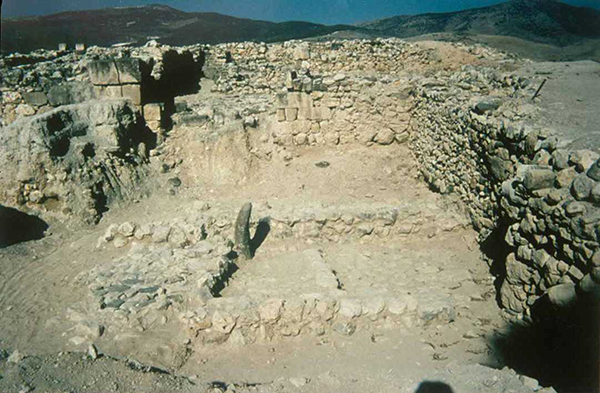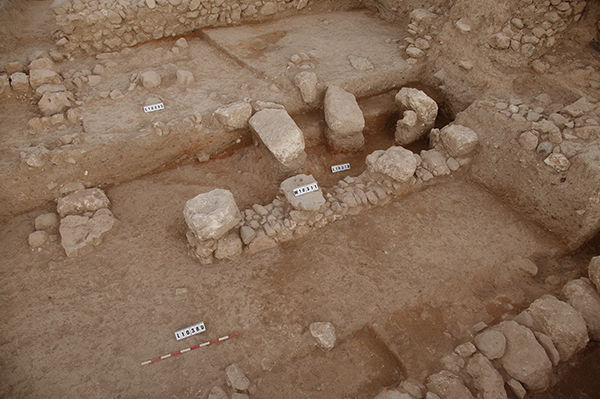 Edit article
Edit articleSeries
Hazor’s Standing Stones: What Do They Commemorate?

Aerial photograph of Tel Hazor. All photos courtesy of The Selz Foundation Hazor Excavations in Memory of Yigael Yadin.
Hazor in the Bible
The Canaanite city-state of Hazor appears in two different biblical stories that contradict each other.
Joshua Destroys Hazor
In the Book of Joshua, after the conquest of the southern half of the land is accomplished (ch. 10), Yabin, king of Hazor, gathers a number of other cities under his banner and leads an army against Joshua (Josh 11:1–5). The battle takes place near the Waters of Merom, in the vicinity of modern-day Tzfat (Safed). Joshua wins the battle handily and then turns to Hazor itself:
יהושע יא:י וַיָּשָׁב יְהוֹשֻׁעַ בָּעֵת הַהִיא וַיִּלְכֹּד אֶת חָצוֹר וְאֶת מַלְכָּהּ הִכָּה בֶחָרֶב כִּי חָצוֹר לְפָנִים הִיא רֹאשׁ כָּל הַמַּמְלָכוֹת הָאֵלֶּה. יא:יא וַיַּכּוּ אֶת כָּל הַנֶּפֶשׁ אֲשֶׁר בָּהּ לְפִי חֶרֶב הַחֲרֵם לֹא נוֹתַר כָּל נְשָׁמָה וְאֶת חָצוֹר שָׂרַף בָּאֵשׁ.
Josh 11:10 Joshua then turned back and captured Hazor and put her king to the sword—Hazor was formerly the head of all those kingdoms. 11:11 They proscribed and put to the sword every person in it. Not a soul survived, and Hazor itself was burned down.
This treatment was reserved for Hazor only:
יהושע יא:יג רַק כָּל הֶעָרִים הָעֹמְדוֹת עַל תִּלָּם לֹא שְׂרָפָם יִשְׂרָאֵל זוּלָתִי אֶת חָצוֹר לְבַדָּהּ שָׂרַף יְהוֹשֻׁעַ.
Josh 11:13 However, all those towns that are still standing on their mounds were not burned down by Israel; it was Hazor alone that Joshua burned down.
Deborah and Barak Defeat Hazor
King Yabin and his city come up again in the story of Deborah and Barak in Judges 4–5, the haftara reading for Parashat Beshalach. The story begins after the death of the Benjaminite judge, Ehud, following which the Israelites sin:
שופטים ד:ב וַיִּמְכְּרֵם יְ־הוָה בְּיַד יָבִין מֶלֶךְ כְּנַעַן אֲשֶׁר מָלַךְ בְּחָצוֹר וְשַׂר צְבָאוֹ סִיסְרָא וְהוּא יוֹשֵׁב בַּחֲרֹשֶׁת הַגּוֹיִם. ד:ג וַיִּצְעֲקוּ בְנֵי יִשְׂרָאֵל אֶל יְ־הוָה כִּי תְּשַׁע מֵאוֹת רֶכֶב בַּרְזֶל לוֹ וְהוּא לָחַץ אֶת בְּנֵי יִשְׂרָאֵל בְּחָזְקָה עֶשְׂרִים שָׁנָה.
Judg 4:2 And YHWH surrendered them to King Yabin of Canaan, who reigned in Hazor. His army commander was Sisera, whose base was Ḥaroshet-ha-goyim. 4:3 The Israelites cried out to YHWH; for he had nine hundred iron chariots, and he had oppressed Israel ruthlessly for twenty years.
Here, the army of Sisera is defeated by Barak; this leads to Israel’s defeat of Yabin.[1] The stories are contradictory—if Joshua killed Yabin and destroyed his city, he would not have been around to dominate the Israelites in the time of Deborah and Barak. They both, however, share a tradition or memory that Hazor was once the dominant Canaanite power in Israel’s north until it was defeated by the Israelites in the pre-monarchic period. The story of Hazor’s dominance and wealth fits with what we know archaeologically.
Hazor in the Bronze Age – the Canaanite City
Hazor, modern Tell el-Qedah or Tel Hazor, was the largest city in the southern Levant during the 2nd millennium B.C.E. Excavation of the Late Bronze Age (15th–13th cent. B.C.E.) stratum has revealed palaces, temples, gates, and domestic buildings throughout the city.
The city covered an area of approximately 84 hectares (208 acres), encompassing both a lower city and an acropolis (upper city), complete with a large ceremonial precinct (a building and two courtyards) in its center and an administrative palace on its northern slope.[2] This area of habitation is huge for an ancient city in the Levant. Its importance is also reflected in its connections and correspondence with both neighbors to the north as well as the Egyptian empire in the south.
The Late Bronze Age city was destroyed in a large conflagration, which can been seen clearly in the very thick destruction layer (measuring 2–3 meters) that includes burnt mudbricks, burnt wooden beams, broken pottery vessels, as well as a variety of other finds. Who destroyed Hazor is a matter of scholarly debate. Some believe these were the proto-Israelites,[3] while others argue that it was the city dwellers themselves.[4]
Iron Age Hazor: An Overview of the Israelite City
Following a gap of about 150 years, the acropolis was resettled, this time by Israelites, while the lower city was never settled again.
Sparse Settlement (Iron I)—In the 11th century B.C.E., a small settlement was built on Hazor’s acropolis. This settlement includes meager walls and dozens of pits. These pits were dug into the destruction layer of the previous Canaanite city, which were probably still in view when the new settlement was built. In the vicinity of these pits, a small cultic installation was found (see below). In addition, an open cultic site was found in the westernmost part of the acropolis.
Rebuilding (Iron IIa)—Things changed dramatically in the 10th century B.C.E., when the city “rose from the ashes.” This is the period, according to the Bible, of the united monarchy under David and Solomon, and Solomon is credited by the Bible with having built it (1 Kgs 9:15, 17). This city encompasses the entire western half of the acropolis, surrounded by a casemate wall. In the eastern end of the built city, a six-chamber gate was found, outside of which was a large complex of standing stones (see below). Inside the city, several domestic buildings were also uncovered.
Expansion (Iron IIb)—In the 9th century B.C.E., the time of the Northern Kingdom, the city expanded to the east as well, covering an area of approximately 10 ha. This city is considered a large administrative center and was surrounded by a solid fortification wall. Several large, tripartite storage buildings, as well as large domestic structures were found within this city. In the 8th century, many of the public buildings changed their function and form. These were subdivided into several smaller units, with some being used as workshops while others were probably residential units.
Destruction (Iron IIb)—In the second half of the 8th century, the city was destroyed and never again revived as an urban center. The Bible (2 Kgs 15:29) credits the destruction to the Assyrians under Tiglath-Pileser III, which would place the destruction at exactly 732 B.C.E.
Matzebot (Standing Stones)
One common feature of Canaanite Hazor are cultic standing stones (matzebot). These objects are known in the southern Levant as early as the 11th and 10th millennia B.C.E., i.e., well before what we call historical times, and continue to appear well into the 1st millennium C.E.[5] Standing stones in the southern Levant are almost always left blank (without any inscriptions or figurative descriptions). Therefore, scholars have to speculate about what these stones might have represented, and it is likely they were used for more than one function (sometimes even the same stone may have had multiple functions). The stones could have been used as:
- Memorial stones—to mark the memory of the deceased.
- Legal markers—to mark a legal relationship between individuals or entities.
- Commemorative stones—to commemorate an event and remind people of its honor and glory.
- Cultic markers—to note the exact location where the deity can be found, or to mark the exact location where worship and cultic activities will reach the deity.
Each standing stone was not limited to one function and could have had several functions.[6]
Iron I and Iron IIa Israelite strata at Hazor also had standing stones. Finding matzebot in an Israelite site is not surprising, as Israelites also made use of such cultic stones,[7] although this was opposed by many of the biblical authors.[8] Nevertheless, the unique aspects of the configuration of the Israelite standing stones, found in three areas in Hazor, imply that they represent something altogether different than those of their Canaanite predecessors.
The Standing Stone Lookout (Iron I)
The first site was excavated in 1958 by Yigael Yadin. It is located in the westernmost part of the tel, in a complex defined by shallow walls. It was built on top of a Late Bronze Age thick wall and is partly sealed by the 10th century B.C.E. casemate wall. In the south-western corner of this cultic place, a large basalt standing stone was found. A hoard of bronze objects (including a bronze figurine of a Canaanite deity) was placed next to it in a jug.[9]
Although we do not know whether or not this cultic place is built directly on top of the LBA destruction level (since Yadin did not excavate below the level of this complex), it is at least built in a location which provides a full view of the destruction of both the LBA Ceremonial Precinct in the center of the acropolis as well as the administrative palace on the northern slopes of the tel, both still standing in their ruins.
In addition, this installation is located at the highest point of the acropolis, on the northern edge of the western part of the acropolis, overlooking the ruins of the Lower City, which stood abandoned at this time.

The Standing Stone Circle (Iron I)
A second cult installation was excavated in 2005. It consists of a circle of small standing stones before a large basalt standing stone. The three offering tables on the side indicate the cultic nature of this area, which is defined by a shallow wall to the east of the large standing stone. This is an open cultic installation which was dug into the ruins of the Late Bronze Age courtyard of the Ceremonial Precinct, not built upon during this time.[10]

The Standing Stone Complex (Iron IIa)
In the 10th century B.C.E., a new complex of standing stones was built outside the city walls, not far from the gate of the city. This complex, which was excavated in 2010 and 2011, includes four large, elongated stones, three of which are made of limestone and the fourth of basalt. Nearby were four flat large stones, which could have served either as offering tables or as bases to the elongated stones.
The standing stones were built inside a complex defined by four walls, three of which are built of one course of large, unhewn boulders. The fourth and southern wall of this complex was built directly on top of the destruction level of the Late Bronze Age administrative palace, not built upon prior to the construction of this complex. It is important to note that the complex is built on the destruction remains closest to the gate of the 10th century city.[11]
The complex of standing stones was eventually decommissioned while the city was still functioning. Thus, the four elongated stones were all found lying flat on their back next to the four flat stones. It is clear this was done carefully and purposefully. Moreover, prior to being taken out of use, the entire complex was cleaned; no complete vessels were found in the complex, and in fact very few sherds were unearthed in the complex. In other words, the complex was not violently destroyed but reverentially buried; we do not know by whom or why.


As noted above, the placement of this complex is significant: It was built near the main city gate, only 30 meters to the north, and is situated in the closest possible location from the gate where the remains of the destruction would have still been visible.
Matzebot as Commemorative
What was the function of the standing stones? What were they meant to represent? Though it is possible to suggest that since the first and second installations had a single stone or a prominent stone these might be representations of a deity, the fact that the second and third cultic site have numerous stones implies that we are not speaking of such a cultic matzebah. In fact, the latter two sites are reminiscent of biblical texts that describe setting up multiple standing stones in the context of commemorations.
For example, after the revelation at Sinai and the transmission of the Covenant Collection:
שמות כד:ד וַיִּכְתֹּב מֹשֶׁה אֵת כָּל דִּבְרֵי יְ־הוָה וַיַּשְׁכֵּם בַּבֹּקֶר וַיִּבֶן מִזְבֵּחַ תַּחַת הָהָר וּשְׁתֵּים עֶשְׂרֵה מַצֵּבָה לִשְׁנֵים עָשָׂר שִׁבְטֵי יִשְׂרָאֵל.
Exod 24:4 Moses then wrote down all the commands of YHWH. Early in the morning, he set up an altar at the foot of the mountain, with twelve pillars for the twelve tribes of Israel.
Similarly, in the Book of Joshua, Joshua has the Israelites arrange two sets of pillars after they cross the Jordan River. First, one set is placed in the Jordan itself:
יהושע ד:ט וּשְׁתֵּים עֶשְׂרֵה אֲבָנִים הֵקִים יְהוֹשֻׁעַ בְּתוֹךְ הַיַּרְדֵּן תַּחַת מַצַּב רַגְלֵי הַכֹּהֲנִים נֹשְׂאֵי אֲרוֹן הַבְּרִית וַיִּהְיוּ שָׁם עַד הַיּוֹם הַזֶּה.
Josh 4:9 Joshua also set up twelve stones in the middle of the Jordan, at the spot where the feet of the priests bearing the Ark of the Covenant had stood; and they have remained there to this day.
Joshua 4:5–8 narrates setting up the second set, as Joshua commands twelve men to bring stones from the river bed out onto dry land as a memorial. The command is subsequently carried out and explained:
יהושע ד:כ וְאֵת שְׁתֵּים עֶשְׂרֵה הָאֲבָנִים הָאֵלֶּה אֲשֶׁר לָקְחוּ מִן הַיַּרְדֵּן הֵקִים יְהוֹשֻׁעַ בַּגִּלְגָּל. ד:כא וַיֹּאמֶר אֶל בְּנֵי יִשְׂרָאֵל לֵאמֹר אֲשֶׁר יִשְׁאָלוּן בְּנֵיכֶם מָחָר אֶת אֲבוֹתָם לֵאמֹר מָה הָאֲבָנִים הָאֵלֶּה. ד:כב וְהוֹדַעְתֶּם אֶת בְּנֵיכֶם לֵאמֹר בַּיַּבָּשָׁה עָבַר יִשְׂרָאֵל אֶת הַיַּרְדֵּן הַזֶּה.
Josh 4:20 And Joshua set up in Gilgal the twelve stones they had taken from the Jordan. 4:21 He charged the Israelites as follows: “In time to come, when your children ask their fathers, ‘What is the meaning of those stones?’ 4:22 tell your children: ‘Here the Israelites crossed the Jordan on dry land….’”
The use of standing stones at Hazor may be another example of such practice. But what do they commemorate?
Installations of a Ruin Cult
In all three cases at Hazor, the standing stones were set up in relation to the destruction level of the Canaanite city, which was still standing in its ruins. Thus, I believe that all three complexes were part of a tradition of “ruin cult” which took place at Hazor.[12]
Ruin cult refers to cultic practices that are conducted in relation to ruins of a previous culture or settlement. The ruins are the focus of the ritual activities. This cultic practice is well-attested in the Aegean area from the end of the second millennium and the beginning of the first millennium. At sites where this practice was identified, the ruins functioned as the context of the cult performed by the inhabitants of the earliest Iron Age settlement.
Some also argued that the ruins served as the actual object of cult. Standing stones were incorporated in this practice, at times using Bronze Age stones, their use being interpreted as either sacred or profane in this context.[13] Practices of ruin cult are believed to have be used to create socio-political institutions,[14] glorify the past to gain legitimacy under new political and social circumstances,[15] or to express social distinctions using the heroic past of the Bronze Age.[16]
But by designing commemorative installations for the ruins, what were the people trying to convey? Scholars have suggested two opposing interpretations:
Pride in Canaanite Hazor—The late Hebrew University archaeologist, Sharon Zuckerman (1965–2014), argued that both Iron I complexes of standing stones were contemporarily used by the inhabitants of Hazor and its visitors, who treated the ruins with awe and performed ritual ceremonies within these ruins. She suggested that they reflect the admiration of the inhabitants of Hazor of the glorious past of the Canaanite city.[17] Sharon believed that the Iron IIa complex of standing stones was part of the same phenomenon.
Pride in Israelite Conquest—I propose the opposite interpretation: This ruin cult was aimed not at glorifying Hazor’s past greatness, but the Israelite victory over the Canaanite enemy. In fact, the idea of an Israelite ruin cult at Hazor fits with the spirit of the verse in Joshua (11:15) cited above, that the destruction of Hazor was unique.
Whether the Israelites did, in fact, destroy Hazor, or whether the later settlers appropriated this victory from another group, we know from the Bible that the defeat of Hazor was, at some point, considered part of Israel’s legacy.[18] The ruin cult unearthed in Iron I and Iron IIa Hazor is thus evidence for how early this tradition entered Israelite consciousness.
TheTorah.com is a 501(c)(3) nonprofit organization.
We rely on the support of readers like you. Please support us.
Published
February 5, 2020
|
Last Updated
April 14, 2024
Previous in the Series
Next in the Series
Footnotes

Dr. Shlomit Bechar is a post-doctoral fellow at The Haifa Center for Mediterranean History at the University of Haifa. She also conducts ongoing research at the Institute of Archaeology at The Hebrew University of Jerusalem, and is co-director of the excavations at Tel Hazor. Shlomit received her MA in 2012 and PhD in 2019, both from the Hebrew University of Jerusalem. She has been digging at Tel Hazor since 2007 and became co-director of the excavations in 2015. Among her articles are "Take a Stone and Set It Up as a Massebah: The Tradition of Standing Stones at Hazor," (ZDPV, 2018) and "A Renewed Analysis of the Black Wheel-Made Ware of the Intermediate Bronze Age," (Tel-Aviv 2015). Her book, The Effects of Political Changes on Material Culture: The Middle Bronze Age-Late Bronze Age Transition in Northern Canaan as a Test Case is forthcoming with Eisenbrauns, and she is co-author of Hazor VII and is currently co-authoring Hazor VIIII.
Essays on Related Topics:





